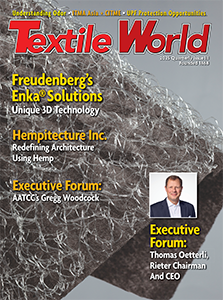VALDESE, N.C. — January 29, 2016 — Meridian Specialty Yarn Group Inc. (MSYG), a specialty yarn manufacturer and producer of package-dyed and space-dyed yarn, has announced a major expansion of its current manufacturing operations in Valdese, North Carolina.
Construction will commence this winter on a new 113,000-square-foot manufacturing plant, which will be located at the company’s current manufacturing site in Valdese. Completion of the project, which includes renovations to the company’s existing 152,000-square-foot plant, is expected by early winter 2017, and will greatly expand Meridian’s current capabilities. A small section of the existing plant will be removed and the final manufacturing operation will span 260,000-square-feet of production and warehouse space. Meridian anticipates spending $8 million on the expansion.
Over the past eight years, as other US companies in the same sector have closed operations or moved overseas, MSYG has continued operations in North Carolina and has emerged a global leader.
The company manufactures and dyes yarn for many industries including home furnishings and upholstery, hosiery, apparel, narrow fabrics, carpets and rugs, sewing thread, craft and industrial textiles. At the company’s wet processing plant in Valdese, Meridian offers the widest range of yarn dyeing products in the industry, including package dyed yarn, three processes of space dyed yarn, top dyed wool, yarn printing and twisting. Today, products made by Meridian Specialty Yarn Group are found in retail and craft stores across the country, and also in carpets, furniture, window treatments, automobiles, tires, socks and more.
“We believe a strong manufacturing base is crucial to the US economy and we will do all that we can to support our customers, our employees and the communities in which we operate,” said Tim Manson, president of the company.
Meridian has had operations in Valdese since 1994. Manson added that a great deal of thought, study and time went into the decision to stay in Valdese. The company currently employees 146 employees and the expansion will result in 25 additional jobs.
“We are excited about the opportunity this new investment represents for us from a business perspective, and also for the town and for our employees,” said Manson. “When we developed the business plan for the expansion, we did a great deal of due diligence with regard to the location, and concluded the best place to be is where we are. We greatly appreciate the support of the city and county in helping us though this process.”
MSYG is one of the town’s major corporate citizens.
“This is a significant announcement for the Town of Valdese,” said Valdese Mayor Chip Black. “We have worked with Meridian for many months to facilitate the process and find a solution that supports their tremendous growth opportunities while remaining here in Valdese.”
Basic Facts
Plant location: 312 Colombo Street SW, Valdese, North Carolina 28690
Parent company: Meridian Industries, http://www.meridiancompanies.com/
How long in operation: MSYG has been in operation in Valdese since 1994
Square footage of existing plant: 152,000
Square footage of new plant: 113,000
Square footage of completed operation: 260,000
Number of current employees in Valdese: 146
Number of new jobs: 25
Capabilities (Valdese plant): Package dyed yarn, three processes of space dyed yarn, top dyed wool, yarn printing and twisting
Posted January 29, 2016
Source: Meridian Specialty Yarn Group, Inc.




